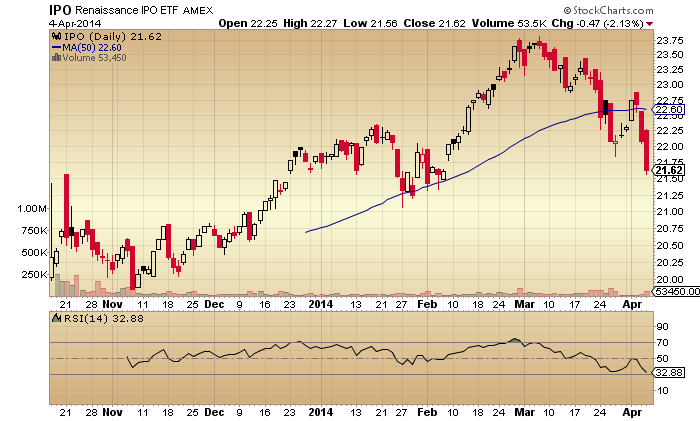
We have an old saying on Wall Street – “When the ducks are quacking, feed them.”
No one knows exactly who coined this phrase, its first known published usage came from a May 1991 article in which the head of First Boston’s equities desk was quoted as saying it. Keep in mind that 1991 predated all of the Internet, wireless, optical, genomic, telco networking, software, e-retailing and B2B bubbles of the 90’s, not to mention the real estate and credit bubble of the mid-aught’s, the oil and gold rushes that accompanied it and our own modern Web 2.0 social n’ cloud-computing extravaganza.
Which is to say that quacking ducks clamoring for the next big thing and Wall Street rushing to meet that demand is not a new phenomenon. The more you read about Wall Street history, the more you recognize it as the world’s most elaborate petting zoo – lambs, ducks, goats, cows and pigs herded into pens so that bankers and brokers can feed them pellets right from their hands. We are fed until the bursting point, we almost never walk away on our own.
Owning IPOs has been an incredible investment strategy for investors during the recent Relentless Bull that began in the fall of 2011 and continues to this day. Deutsche Bank looked at the technology IPO class of 2012 this past January to get a sense of how these stocks had done for investors who’d held on through year-end 2013. You’ll be amazed to know that “the average tech IPO from 2012 is up an astonishing 170 percent from its offering price. Eighteen of forty-two tech IPOs from 2012 are up over 100 percent from their offering price, while just nine trade below their offer price and four have been acquired. The IPO Class of 2012 has added more than $111 billion of market capitalization since IPO ($57 billion by Facebook, $54 billion by all other IPOs combined).”
In other words, it’s been good to be in the game for just about everyone – bankers, traders, early shareholders, syndicate, selling group, brokers, even mom and pop.
2013 was another banner year for IPOs, the best one since 2000. A total of 222 companies went public last year raising $55 billion. According to the new issue mavens at Renaissance Capital, the IPO window had not been closed at all during the entire year – quite rare. As for performance, the average return on these 222 2013-vintage new issues was 41percent, a scorching average considering the fact that it includes $55 billion worth of new supply, half of which came from private equity-backed re-treads (The Container Store, Extended Stay America etc).
Which brings us to 2014.
This week, we’re likely to see Stalwart Tankers make its debut on the New York Stock Exchange in a $186 million IPO. The company, which I can only assume is a fleet of ships carrying printed blog posts written by Joe Weisenthal between continents, will be joining one of the fullest weeks for new issues in a long time, coming as it does alongside the $3 billion Ally Financial deal and the PE regurgitation of La Quinta hotels for close to $900 million.
Even before this coming week, the ducks have been exceptionally well-fed this year. The sixty-plus IPOs of Q1 2014 represented a 100 percent jump over what we saw in the first quarter of last year. Total dollars raised for new issues also jumped by 40 percent to $10.6 billion. Half of the IPOs that came since the year began have been healthcare, with a record twenty six biotechs in the mix and eleven new technology stocks (mostly software as a service plays) hitting the market. 70 percent of this quarter’s new issues were highly speculative companies losing money over the prior year. Eight of the biotech offerings traded up 50 percent from their offering price while two of them doubled.
But some signs have appeared over the last few weeks that would indicate the ducks are close to satiated if not completely stuffed.
King Digital Entertainment, the enormously profitable maker of the Candy Crush game, was basically crotch-punched upon arrival. The Street doesn’t believe it can repeat its success or hold onto the world’s attention for much longer. It was overpriced and the market called bullsh*t.
Billionaire Wilbur Ross dropped plans to IPO his Diamond S Shipping conglomerate on March 12 citing an unsatisfactory suggested price from the underwriters. One week later, the CEO of Globoforce (another SaaS company) admitted there wasn’t enough investor demand to meet the valuation he’d wanted for his company, saying “Despite receiving overwhelming interest in our initial public offering, we have decided to postpone our offering until market conditions are more favorable for our company and our customers.” Translation: We promised everyone more, we’ll wait for a hornier tape.
And while IPOs are the focal point here, let’s not forget the flurry of secondary stock sales, private equity exits and lockup expirations hitting the tape nearly every day. The LBOs are cashing out, founders and VCs are cashing out, newly-public company employees are cashing out – all against the backdrop of a (slightly) less accommodative Fed. This is a separate discussion, but a digression worth spending a half a second on…
Meanwhile, there is no better gauge of the public’s continued appetite for IPO shares than the IPO ETF itself.
Launched this past October, the Renaissance IPO ETF (ticker is IPO, obvs) gives us a real-time indicator of how the shares of recently debuted names are acting. To give you a quick idea of what’s in this basket, the largest newly-IPO’d stocks are added within five days of coming public and held for approximately two years, until such time as they are considered non-IPOs and replaced in the index. Current large holdings include Facebook (not for long), Zoetis, FireEye, Splunk, Workday, Realogy, Twitter and Sprouts Farmers Market. For obvious reasons, the ETF is almost 30 percent technology stocks and trades for 25 times earnings.
This past week, the IPO ETF slashed below its 50-day moving average, but it’s held the lows of this past February’s sell-off so far. More ominously, IPO’s relative strength index (RSI, in the pane below) took out its lows from earlier this year, a sign that momentum is actually getting worse than price would indicate in and of itself.

IPO is down 8 percent over the last month while the S&P 500 total return index is flat.
But every cycle ends the same way. Eventually, the sheep stop bleating, the cows stop lowing and the ducks aren’t quacking quite so enthusiastically. Eventually supply catches up with demand and then overwhelms it. No one waves a sign or rings a bell, it’s just a process that some people recognize as being underway faster than others – and there are always false alarms.
I’m going to leave you with this quote from Fred Schwed’s ‘Where are the Customer’s Yachts‘ that bears repeating here, even if the advice is too extreme and vague to be quite as utilitarian as it is clever:
“When there is a stock-market boom, and everyone is scrambling for common stocks, take all of your common stocks and sell them. Take the proceeds and buy conservative bonds. No doubt the stocks you sold will go higher. Pay no attention to this— just wait for the depression which will come sooner or later. When this depression— or panic— becomes a national catastrophe, sell out the bonds (perhaps at a loss) and buy back the stocks. No doubt the stocks will go still lower. Again pay no attention. Wait for the next boom. Continue to repeat this operation as long as you live, and you’ll have the pleasure of dying rich.”
Fred would likely have characterized the the IPO gold rush of the last six months as a “stock-market boom” to be sure. And while he would not necessarily be liquidating his complete portfolio today, he would almost certainly be saying “no thank you” to any more new issues – especially of the tech and healthcare variety.
The only thing more worrisome than the black swan we can’t see is the fattened duck we can.




Thorn of Girl
Excellent info is often uncovered on this net blog site.
[…] Fear the walking dead: Usually headed up by crooks & clowns – whose names, faces, and business strategies change every couple of years, whose press releases & filings are usually out of date/scarcely believable, who are always flouting the regulators (but never seem to get prosecuted?!), and whose losses/outstanding shares climb relentlessly (so they fool investors with serial reverse-splits). [If in doubt, late/non-existent regulatory filings are a great filter. And no, I didn’t screen for fraud…they usually have such ridiculous stories & valuations, it’s irrelevant whether they’re frauds!] But cryptocurrencies & blockchain are en fuego now, so as they say on Wall Street: […]
[…] thrives on selling new strategies to people who don’t know better. This is a case of “When the ducks are quacking, feed them“. Investors (it’s tempting to say retail investors, but supposedly sophisticated […]
… [Trackback]
[…] Information on that Topic: thereformedbroker.com/2014/04/06/quack-quack-demand-meet-supply/ […]
… [Trackback]
[…] Info on that Topic: thereformedbroker.com/2014/04/06/quack-quack-demand-meet-supply/ […]
… [Trackback]
[…] Here you can find 32935 more Info on that Topic: thereformedbroker.com/2014/04/06/quack-quack-demand-meet-supply/ […]
… [Trackback]
[…] Here you can find 48667 additional Information to that Topic: thereformedbroker.com/2014/04/06/quack-quack-demand-meet-supply/ […]
… [Trackback]
[…] Find More Information here on that Topic: thereformedbroker.com/2014/04/06/quack-quack-demand-meet-supply/ […]
… [Trackback]
[…] Find More Info here to that Topic: thereformedbroker.com/2014/04/06/quack-quack-demand-meet-supply/ […]
… [Trackback]
[…] Read More Info here to that Topic: thereformedbroker.com/2014/04/06/quack-quack-demand-meet-supply/ […]
… [Trackback]
[…] Read More on on that Topic: thereformedbroker.com/2014/04/06/quack-quack-demand-meet-supply/ […]
… [Trackback]
[…] Information to that Topic: thereformedbroker.com/2014/04/06/quack-quack-demand-meet-supply/ […]